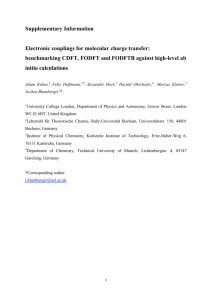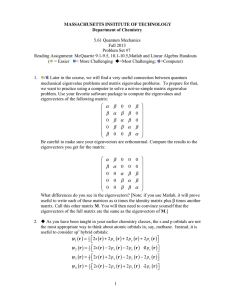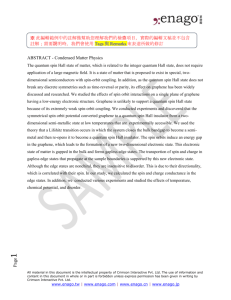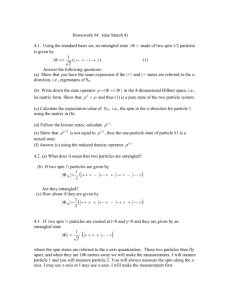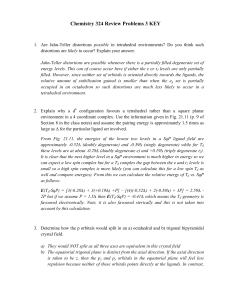SUPPORTING INFORMATION Proton Reduction at Surface of
advertisement
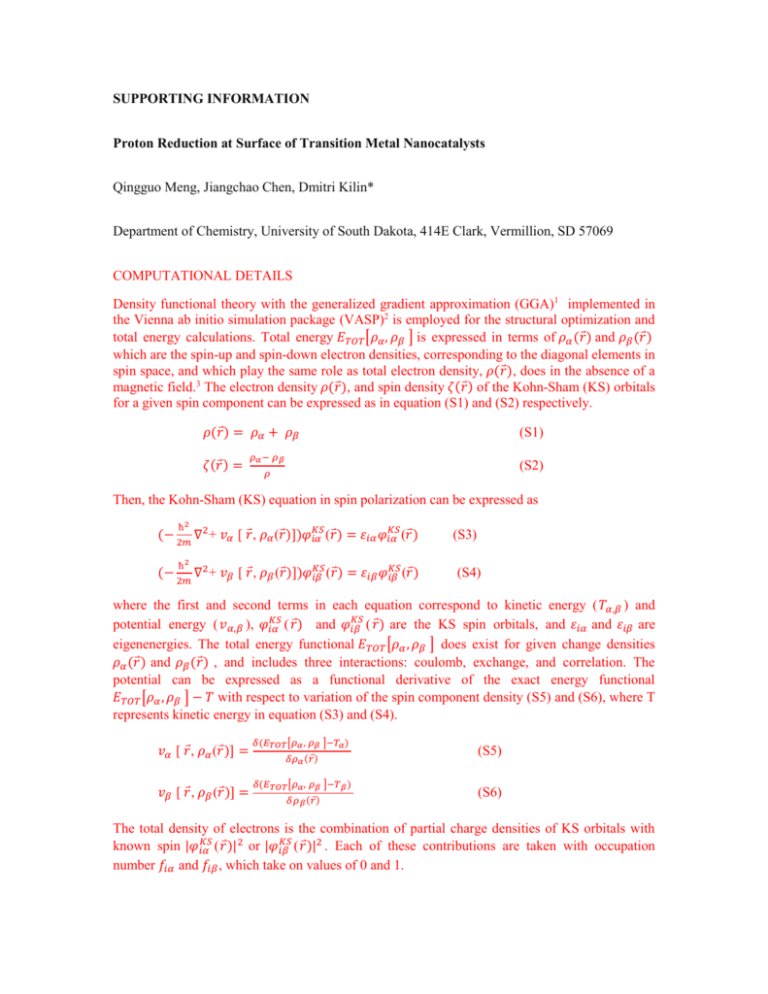
SUPPORTING INFORMATION Proton Reduction at Surface of Transition Metal Nanocatalysts Qingguo Meng, Jiangchao Chen, Dmitri Kilin* Department of Chemistry, University of South Dakota, 414E Clark, Vermillion, SD 57069 COMPUTATIONAL DETAILS Density functional theory with the generalized gradient approximation (GGA)1 implemented in the Vienna ab initio simulation package (VASP)2 is employed for the structural optimization and total energy calculations. Total energy 𝐸𝑇𝑂𝑇 [𝜌𝛼 , 𝜌𝛽 ] is expressed in terms of 𝜌𝛼 (𝑟⃑) and 𝜌𝛽 (𝑟⃑) which are the spin-up and spin-down electron densities, corresponding to the diagonal elements in spin space, and which play the same role as total electron density, 𝜌(𝑟⃑), does in the absence of a magnetic field.3 The electron density 𝜌(𝑟⃑), and spin density 𝜁(𝑟⃑) of the Kohn-Sham (KS) orbitals for a given spin component can be expressed as in equation (S1) and (S2) respectively. 𝜌(𝑟⃑) = 𝜌𝛼 + 𝜌𝛽 𝜁(𝑟⃑) = (S1) 𝜌𝛼 − 𝜌𝛽 (S2) 𝜌 Then, the Kohn-Sham (KS) equation in spin polarization can be expressed as ħ2 𝐾𝑆 𝐾𝑆 (− 2𝑚 ∇2 + 𝑣𝛼 [ 𝑟⃑, 𝜌𝛼 (𝑟⃑)])𝜑𝑖𝛼 (𝑟⃑) = 𝜀𝑖𝛼 𝜑𝑖𝛼 (𝑟⃑) (− ħ2 2 ∇ + 2𝑚 𝐾𝑆 𝐾𝑆 𝑣𝛽 [ 𝑟⃑, 𝜌𝛽 (𝑟⃑)])𝜑𝑖𝛽 (𝑟⃑) = 𝜀𝑖𝛽 𝜑𝑖𝛽 (𝑟⃑) (S3) (S4) where the first and second terms in each equation correspond to kinetic energy ( 𝑇𝛼,𝛽 ) and 𝐾𝑆 𝐾𝑆 potential energy ( 𝑣𝛼,𝛽 ), 𝜑𝑖𝛼 ( 𝑟⃑) and 𝜑𝑖𝛽 ( 𝑟⃑) are the KS spin orbitals, and 𝜀𝑖𝛼 and 𝜀𝑖𝛽 are eigenenergies. The total energy functional 𝐸𝑇𝑂𝑇 [𝜌𝛼 , 𝜌𝛽 ] does exist for given change densities 𝜌𝛼 (𝑟⃑) and 𝜌𝛽 (𝑟⃑) , and includes three interactions: coulomb, exchange, and correlation. The potential can be expressed as a functional derivative of the exact energy functional 𝐸𝑇𝑂𝑇 [𝜌𝛼 , 𝜌𝛽 ] − 𝑇 with respect to variation of the spin component density (S5) and (S6), where T represents kinetic energy in equation (S3) and (S4). 𝑣𝛼 [ 𝑟⃑, 𝜌𝛼 (𝑟⃑)] = 𝑣𝛽 [ 𝑟⃑, 𝜌𝛽 (𝑟⃑)] = 𝛿(𝐸𝑇𝑂𝑇 [𝜌𝛼 , 𝜌𝛽 ]−𝑇𝛼 ) 𝛿𝜌𝛼 (𝑟⃑) 𝛿(𝐸𝑇𝑂𝑇 [𝜌𝛼 , 𝜌𝛽 ]−𝑇𝛽 ) 𝛿𝜌𝛽 (𝑟⃑) (S5) (S6) The total density of electrons is the combination of partial charge densities of KS orbitals with 𝐾𝑆 𝐾𝑆 known spin |𝜑𝑖𝛼 ( 𝑟⃑)|2 or |𝜑𝑖𝛽 (𝑟⃑)|2 . Each of these contributions are taken with occupation number 𝑓𝑖𝛼 and 𝑓𝑖𝛽 , which take on values of 0 and 1. 𝐾𝑆 𝜌𝛼 (𝑟⃑) = ∑𝑖 𝑓𝑖𝛼 |𝜑𝑖𝛼 (𝑟⃑)|2 (S7) 𝐾𝑆 𝜌𝛽 (𝑟⃑) = ∑𝑖 𝑓𝑖𝛽 |𝜑𝑖𝛽 (𝑟⃑)|2 (S8) Equations (S3)-(S8) are solved in an iterative manner in VASP. The orbital character is analyzed by projecting the wavefunctions onto spherical harmonics within spheres of a Wigner–Seitz radius around each ion4. The output contains the decomposition of hybrid molecular orbitals into the form of s, p d, and f orbital contributions from each ion to each hybrid molecular orbital. It is important to note that the total number of electrons can be different for spin α and β, as represented in the following equations, which is the basic concept for constrained DFT 5. 𝑁𝛼 = ∫ 𝜌𝛼 𝑑𝑟 = ∑𝑖 𝑓𝑖𝛼 (S9) 𝑁𝛽 = ∫ 𝜌𝛽 𝑑𝑟 = ∑𝑖 𝑓𝑖𝛽 (S10) The sum of (𝑁𝛼 + 𝑁𝛽 ) is fixed and equals the total number of electrons. BACKGROUND CHARGE IN DFT: The convergence of the electrostatic energy in calculations using periodic boundary conditions is considered in the context of periodic solids and localized aperiodic systems in the gas and condensed phases. Conditions for the absolute convergence of the total energy in periodic boundary conditions are obtained, and their implications for calculations of the properties of polarized solids under the zero-field assumption are discussed. For aperiodic systems the exact electrostatic energy functional in periodic boundary conditions is obtained. The convergence in such systems is considered in the limit of large supercells, where, in the gas phase, the computational effort is proportional to the volume. It is shown that for neutral localized aperiodic systems in either the gas or condensed phases, the energy can always be made to converge as O(L-5) where L is the linear dimension of the supercell. For charged systems, convergence at this rate can be achieved after adding correction terms to the energy to account for spurious interactions induced by the periodic boundary conditions. These terms are derived exactly for the gas phase and heuristically for the condensed phase. Figure S1. DOS of Pd13H24 ̶ (left) and Pd13H24+ (right) clusters. 1. Juan, Y. M.; Kaxiras, E.; Gordon, R. G., Use of the Generalized Gradient Approximation in Pseudopotential Calculations of Solids. Physical Review B 1995, 51 (15), 9521-9525. 2. Hafner, J., Ab-initio simulations of materials using VASP: Density-functional theory and beyond. Journal of Computational Chemistry 2008, 29 (13), 2044-2078. 3. Yang, R. G. P. a. W., Density -Functional Theory of Atoms and Molecules. Oxford University Press: 1994. 4. (a) Girifalco, L. A., Statistical Mechanics of Solids Oxford University Press: 2000; (b) Politzer, P.; Parr, R. G.; Murphy, D. R., Approximate determination of Wigner-Seitz radii from free-atom wave functions. Physical Review B 1985, 31 (10), 6809-6810. 5. Kaduk, B.; Kowalczyk, T.; Van Voorhis, T., Constrained Density Functional Theory. Chemical Reviews 2011, 112 (1), 321-370.



